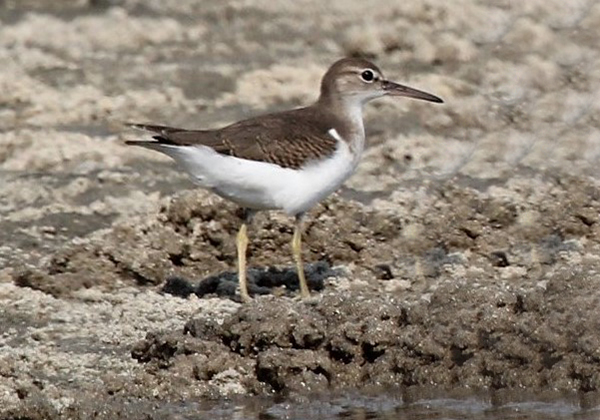WILLIS WHARF OVERLOOK
In Brief: Interpretive saltmarsh overlook renowned for sizable Marbled Godwit roost (August to April) at higher/rising tide. Excellent spot for scoping distant shorebirds, with lesser numbers of waterfowl, terns, gulls, and occasional loons and grebes.
Access: Open daily, dawn to dusk (not gated; earlier and later also legal). Port-a-johns available at boat launch and overlook platform.
Additional Info: Virginia DGIF Birding Trail Site
EVERYTHING YOU NEED TO KNOW ABOUT BIRDING WILLIS WHARF OVERLOOK
Willis Wharf is a small “seaside” community east of Exmore whose chief industry is aquaculture, mostly the farming of clams and oysters. The town sits on Parting Creek where the creek flows into the Great Machipongo River, and at lowest tide, a large area of mudflat lies exposed on the opposite bank from the town and overlook area. Virtually all of the habitat here lies in Accomack County, visible on the far shore (Bell Neck, opposite the town, and Upshur Neck, farther to the east). Because this site is checked religiously, if often briefly, by so many birders visiting the Eastern Shore, the list of shorebird species detected is a respectable 27, though some of these have been seen just once here: Hudsonian Godwit, Black-necked Stilt, American Avocet, American Golden-Plover, and Stilt Sandpiper, and others just a few times, such as Pectoral Sandpiper. These species tend to prefer freshwater sites, as do Solitary Sandpiper and Lesser Yellowlegs (both rather scarce here) or plowed fields (golden-plover). Long-billed Curlew is unrecorded at Willis Wharf but is found in small numbers (up to 3) in the nonbreeding season just to the east (see Boat Tours section).
As with all seaside shorebirding activity, timing is everything at Willis Wharf. Willis Wharf shorebirding is best during a rising tide, which concentrates the birds into smaller areas for feeding and then into roosts. Rising sea levels today mean that the birds cannot remain here during high tide but most move on to even higher areas, so if one arrives at high tide, the area will be covered with water (and few or no birds). At low tide, when large areas of mudflat are exposed, there can similarly be few or no shorebirds present, as they have moved on to more productive, wetter foraging areas. When birds are packed into roosts tightly (about an hour before high tide), it can be difficult to tease out and identify the smaller species among the Marbled Godwits here, so plan on arriving about 2 hours or more before high tide to see the birds foraging, then gathering up into roosts. During the nonbreeding season, a good variety of birds should be present. In late fall and winter, and even into early spring, hundreds of beautiful Marbled Godwits (up to 455) gather here, the largest number in the mid-Atlantic states by far. Among these birds, Hudsonian Godwits are exceedingly rare, with few credible records, but they should be looked for nonetheless, chiefly in autumn (the species is hardly known in the East in spring). Bar-tailed Godwit should be kept in mind as well, with Black-tailed an even more remote possibility, as that species gravitates to freshwater habitats during migration, as does Hudsonian.
Spotted Sandpiper
Whimbrel
Willets are typically present on the flats year-round, with Eastern Willets present April through August and Western Willets July through April (a few non-breeding second-year Westerns remain through the summer months here). Willets are usually the second most numerous shorebird species here, unless large numbers of Dunlin are present; counts up to 1000 are not unusual here in late winter, and typically a handful of Western Sandpipers will be present at such times (looking like a miniature Dunlin). Short-billed Dowitchers and Greater Yellowlegs can be seen among the godwits and Willets at most times of year but are most numerous during migration and winter; Long-billed Dowitcher tends to be much less common but is recorded here almost every year recently. Rarely Red Knot is recorded, usually just 1-2 birds tucked in among the roosting masses. Whimbrels tend to be found here in spring (May) and fall (August), with a few possible at almost any time of year except winter, when very rare here. Migratory periods are also the best time to find Semipalmated, Spotted, and Least Sandpipers at Willis Wharf; Ruddy Turnstones favor the shell piles around the processing plants but are also seen on the flats at times. Sanderlings can also be found sparingly, mostly during their migration times or strong easterly gales. Semipalmated Plovers are common here during migration and now also fairly common in winter (check the flats on the west side of the bridge). American Oystercatchers are seen in small numbers year-round; watch for individuals with leg flags, as these can sometimes be read with a scope. Data about their movements can be very helpful to researchers studying this declining iconic species of the intertidal zones. Killdeer nest locally, and a few are on the flats year-round.
Willis Wharf makes a pleasant stop at any time of year for a picnic and long stay to see what might fly in. Passerines are not the draw here, as the few nesting species are widespread and no unusual species have been reported (White-crowned Sparrow the most interesting thus far). In addition to shorebirds, gulls, terns, raptors, and waterfowl make up most of the checklist at Willis Wharf. Gull-billed Terns are regular here in May and August, among most of the regular tern species; Black Skimmers are often common, while Black Tern is rare but recorded on multiple occasions. During very high tides in later fall and winter, watch for marsh sparrows (especially Saltmarsh and Nelson’s) in the sections of marsh nearest the platform. Nelson’s migrate quite late in the spring, so they are possible here through May. Rails also sometimes make an appearance, though Clapper is by far the most likely. Two lucky fellows, birding during a strong nor’easter with high tides, watched a Yellow Rail clamber up into an Eastern Redcedar for shelter here on 17 November 1994. Waterfowl and raptors are normally present year-round, though summer is limited for both. In winter, Snow Goose flocks have held Ross’s, and Canada Goose flocks at least one Greater White-fronted in October. Mergansers are common here (except Common, which is very rare), as are Bufflehead. Common Goldeneye and Long-tailed Duck, which feed on shellfish in bays to the east of Willis Wharf, often make appearances here at high tide or during inclement weather, as do Horned Grebes and Common Loons. American White Pelican, Sandhill Crane, and Golden Eagle are represented by cameo appearances but could be expected again on October cold fronts, as data from Kiptopeke State Park indicate, and the same is true of Cave Swallows, seen here 8 December 2012 but likely to be recorded again in late fall (November or early December). October is also a fine time to see falcons at Willis Wharf, sometimes in pursuit of a shorebird meal. New species for this well-watched site should be nicely documented with notes and photographs.
Pied-billed Grebe, Photo: Robet W. Schamerhorn
To venture east of Willis Wharf requires a boat. Hiring an experienced, licensed eco-tour company is the best way to get the most of your time on the water (see Boat Tours section). But for experienced kayakers, there are plenty of fascinating paddles possible from Willis Wharf. More information here.




